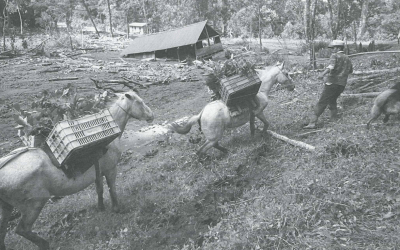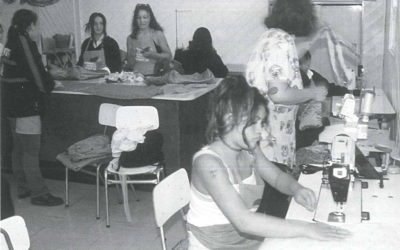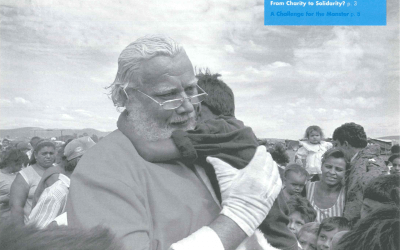Migrant Philanthropy in Latin America
What enables these individuals to do so? Since 1965, Latin America has become one of the primary regions sending migrants to the United States. Rather than severing their ties to their communities of origin, many migrants continue to sustain strong ties to their homelands even as they are incorporated into the U.S. Like the Italian hometown society and Jewish benevolent association members of the past, these migrants also contribute large sums of money, equipment, and ideas toward making their communities better. In some cases, they act independently and do not collaborate with other Hometown Associations (HTAs). In other cases, sending governments learning of these collaborations are putting programs in place to ensure their continuation and enhance their effectiveness.
The Dominican Republic is a case in point. In the late 1970s, migrants from a small Dominican town outside the city of Baja that we’ll call Miraflores, created the Miraflores Development Committee (MDC). Sunday social gatherings gradually evolved into a formal organization dedicated to community development. Over the years, the MDC has raised close to $150,000 to build an aqueduct, a baseball field and stadium, and a funeral home. The Committee’s efforts also paid for renovations at the local school, health clinic, and park. Its next project will be to fix up the local community center.
The MDC has a positive impact that goes way beyond physical improvements. It builds upon the informal solidarity that is an integral part of community life but has never before been harnessed successfully to promote the collective good. By shepherding community improvement projects to completion, the MDC demonstrates to Mirafloreños that the combined efforts of those at home and those abroad can work. Second, migrants introduce U.S. management and administrative techniques that make the MDC more effective and efficient. The checks and balances between home and host community members help ensure that contributions are distributed fairly and guarantee some level of transparency and power-sharing. Third, the MDC generates modest employment when it hires bookkeepers, watchguards, and manual laborers to work on its projects. Finally, the efforts of MDC members in Boston and Miraflores enhance villagers’ ability to make demands of the Dominican state. In some cases, such as health care, the community provided for itself what the government did not provide for them. In the case of the park and the aqueduct, the community leveraged the monies it raised to convince municipal and national officials to give them the money they needed to finish their work. In this way, the MDC’s activities move beyond simple charity to community mobilization.
The Dominican case is not unique. Many migrants from all over Latin America and the Caribbean make major contributions to the communities they leave behind, though the targets of their efforts are not always as locally focused as in the Miraflores case. Dollars raised in New York also mean health clinics, parks, and community centers in Mexico and El Salvador. Alejandro Portes, Patricia Landolt and Kay Eckhoff ‘s work on HTA’s in El Salvador revealed a variety of different types and levels of activities. The Comite de Amigos de Santa Elena (Committee of the Friends of Santa Elena), for instance, has chapters in Los Angeles, San Francisco and Washington which work together to support sports, education, and health activities. Rather than raising funds to finance development projects, other Salvadoran groups support their sending communities by mobilizing political pressure. They write letters to political officials when a clinic or ambulance is needed or when roads still need repair. Both labor migrants and professionals are engaged in these activities. The Salvadoran American Medical Society includes more than 250 Salvadoran physicians in the U.S. who donate clinical services, training, and equipment during yearly visits to El Salvador.
In contrast to the Dominican government, which has done relatively little to promote HTA efforts, the Salvadoran and Mexican governments both actively encourage migrant philanthropy. Luin Goldring, Robert C. Smith, and Gaspar Rivera-Salgado have all written extensively about the Mexican case, highlighting the ways in which governments both at the federal and state level act to stimulate migrants’ continued activism. National government resources helped create statewide federations of hometown associations like the Federation of Zacatecan Clubs of Southern California, which in the mid- to late-1990s included 35 to 45 dues-paying home-town clubs. These federations continue to finance hometown projects and to act as catalysts for better communication between migrants and U.S. and Mexican political authorities. They sponsor student scholarships, soccer tournaments, and political lobbying such as efforts to block the passage of Proposition 187 in California. At the same time, they continue to finance hometown projects, beauty pageants, and cultural events, and to lobby Mexican political authorities in favor of hometown interests. The Mexican government also encourages migrants’ continued involvement through programs such as the Programa para las Comunidades Mexicanas en el Extranjero (PCME ,The Program for Mexican Communities Abroad) which matches federal funds with dollars raised in the U.S.
Both the municipal and national levels of the Salvadoran government have also formed ties with Salvadoran HTAs. Municipal candidates for mayor have campaigned among HTAs in the U.S., promising them goods and services in exchange for their political support. The mayor’s union (Gremio de Alcaldes) held a meeting with a group of approximately 40 HTA’s in Los Angeles. In 1999, the Salvadoran Government also formed the Direccion General de Atencion a la Comunidad en el Exterior. This office, modeled after that of Mexico, seeks to ensure that migrants continue to contribute to their hometowns, to encourage them to invest in El Salvador, and to help link El Salvador with U.S. markets.
Migrant philanthropy and the nature of the state-migrant relations within which these activities develop have stirred much debate. We need to learn more about the relationship between household remittances and the level of community-oriented money flows. Furthermore, some researchers assert that migrants’ greater financial clout imbues them with greater political voice, while others claim that these relations simply recreate old power hierarchies and that migrants and those who stay behind continue to end up footing the bill for services that the government should provide. Clearly, there is no one simple answer. Sending communities generally get better facilities and services, and they may be given a seat, albeit temporary, at the decision making table. But these gains generally come at some cost.
First, when communities get better at solving their own problems, it lets the state off the hook. Because migration enables them to meet their own needs more effectively, national governments can continue to pursue policies that inhibit local development and cause migration to begin with. While communities sending large number of migrants may be in a better position to withstand state negligence, those sending smaller numbers have no comparable safety net and are thus double victims. They have fewer resources to bargain with the state and officials have fewer incentives to help them.
Second, because migrants contribute the bulk of the funds supporting HTA projects, their interests often take precedence over those who stay behind. While at first, both constituencies generally share a vision of their community’s future, migrants gradually come to see sending communities as places for rest and retirement while non-migrants still want jobs and better services. The power dynamics behind decisions concerning what is in the community’s best interest and how it should be acted upon often privilege migrants’ concerns.
The decision to build a funeral home in Miraflores is a case in point. Though pleased with the final product, both migrants and non-migrants felt that far too much money had been spent on this project. They seemed perplexed when asked about how the actual decision to build the funeral home had come about. Each group accused the other of being the project’s most ardent supporters.
Some supported the project because El Llano, a neighboring village, already had a funeral home and villagers did not want to be outdone by their long-standing rival. Others felt that it was migrant community members who had pushed for the project because they now saw Miraflores as a place where they would ultimately come back to retire and die and they wanted a place where they could comfortably do so. Others argued the project was misguided.
“If they had left it up to me to decide, I would not have built it. We are going to break a tradition that we have always had, and we are going to bring a modernization here that we don’t have and that we don’t need… If you ask other Mirafloreños , I bet there would be 70% who would prefer to be laid out and mourned in their own homes. They wouldn’t want to go to a funeral home… I also realize that when people die in the U.S. and are sent home to be buried, if they are laid out in the homes, all of Miraflores goes. But if it is in a funeral home, women have to go to the beauty parlor, men have to wear ties, and you have to have the right clothes and this destroys something about it. Many people prefer not to go. They wait until the family goes back to their home to pay their respects. I know that this is going to happen. It was not a priority” (Gustavo, 43, return migrant, Miraflores).
While HTAs support important social welfare and infrastructure improvements, they have been less successful at stimulating long-term economic growth. A recent study on Oaxacan Hometown Associations in Los Angeles by UCLA’s North American Integration and Development Center examined the extent to which HTAs promoted productive investments in Mexico above and beyond their contributions to social welfare and public works. It also analyzed the role of Mexican government programs in stimulating these activities. The authors concluded that while respondents supported important physical and social improvement projects in their sending communities, they found few examples of efforts that created jobs or that stimulated the local economy. Respondents claimed that the business climate in the region was inhospitable and that they lacked the access to capital, technical assistance and trust in government programs it would take to mount successful ventures. They believed that migrant-driven initiatives to promote regional economic development had great potential but they were skeptical, given their current resources, about their ability to make such schemes work.
Finally, the question of whether migrant philanthropy enhances migrants’ political position is particularly complex. Luin Goldring concludes that programs like the PCME imbue groups with enhanced autonomy and encourage greater political participation. She argues that political authorities have been motivated to include migrants in the national and state communities because of the importance of migrant dollars and as a buffer against Mexico’s perennial economic and political crises. Both Goldring and Robert C. Smith, however, stress that not all migrant groups are equal. In Smith’s comparative work on Zacatecans and Oaxacans, he found that Zacatecans were better positioned to exercise their Mexican citizenship rights and to participate politically in the U.S. and in Mexico.
If nothing else, these dynamics bring to light the changing boundaries of community development and political participation. Clearly, the links between sending-community and immigrant-community development will only grow stronger. Furthermore, the character of the state-subject relationship is increasingly shaped by factors outside the nation state.
Spring 2002, Volume I, Number 3
Related Articles
Obras de Infraestructura Básica de Fácil Ejecución a través de la Autogestión
En el Ecuador rural y en las zonas citadinas marginales, la carencia de servicios básicos se ha convertido en un mal endémico no resuelto hasta …
Responsabilidad Social Empresarial: Algunos Hechos Que Cuentan
La Responsabilidad Social Corporativa (RSC) es una temática más bien nueva en Chile. Aún cuando se encuentran acciones filantrópicas desde tiempos de la colonia, la relación de la …
Algunos Casos en Chile
Un caso fue José Tomás Urmeneta, un empresario del siglo XIX quien, en un momento de auge del sector agroexportador chileno, en su testamento dejó asignados recursos para …




